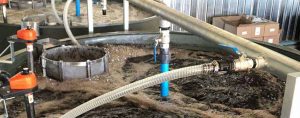Many farmers are experiencing reduced profit margins due to drought, low product prices, and high input cost. In order to survive, they are forced to cut costs to the bone. Continued investment in soil fertility is normally the first casualty. Allow me to explain why this is the wrong approach.
Agriculture has become too much input orientated. This results in lower profit margins. To remedy this, we need to stop treating the symptoms, and address the underlying cause.
The application of inorganic fertilisers stimulates bacterial communities, that actively burn soil carbon. Without enough additional organic matter to counter, the soil will lose carbon and become less fertile. As carbon reduces, so too does the availability of nutrients and minerals. Even farmers practising conservation agriculture frequently experience a nett loss in soil carbon when using inorganic fertilisers. The carbon use efficiency of crop residues is typically 8% and lower. Only a very small portion of residue is therefore ultimately incorporated into the soil. The rest is lost to the atmosphere.
As soil carbon reduces, so do soil structure and microbial diversity, resulting in compact soil, with little oxygen favouring pathogenic soil organisms. We create the environment for the mostly anaerobic, pathogenic organisms, that outcompete the beneficial, mostly aerobic (needing oxygen) soil microbial community. With their natural predators gone, and plants stressed by an unbalanced chemical diet, pest and diseases thrive. The use of pesticides is also not helping: the application thereof actually increases pesticide utilisation.
“Good soils need less nitrogen, poor soils need more”, says Prof. Richard L Mulvaney (1). And the more you put on, the worse the soil gets. On average, crops use less than 20% of the nitrogen applied (2). The rest kills our soil, pollutes our groundwater, oceans, and atmosphere.
Ask yourself: Why would your crop need all these inputs, while a similar plant in its natural habitat does not?
Consider also the nutrient density of the crops that you produce. Nutritional value and shelve life are dependent upon the organic compounds that the minerals are built into. These compounds are simple in the case of chemical nutrition, and much more complex with a more organic approach. This has a direct bearing on the health of people that consume our products. Nutrients and a full suite of minerals are needed by the immune system. The high incidences of cancer are largely due to the poor quality food that people eat. It is time to do introspection and acknowledge our impact on, and our responsibility towards the farm, community, and wider environment. If not you, then who? If not now, then when? Thankfully, there is a far better and much more profitable way to farm, with minimal need for and use of inorganic pesticides and fertilisers.
References:
- https://www.no-tillfarmer.com/articles/6783-excessive-n-application-burning-the-carbon-pool
- Dourado-Neto, D.; Powlson, D.; Abu Bakar, R.; Bacchi, O.O.S.; Basanta, M.V.; thi Cong, P.; Keerthisinghe, G.;Ismaili, M.; Rahman, S.M.; Reichardt, K.; et al. Multiseason recoveries of organic and inorganic nitrogen-15 in tropical cropping systems. Soil Sci. Soc. Am. J. 2010, 74, 139–152




